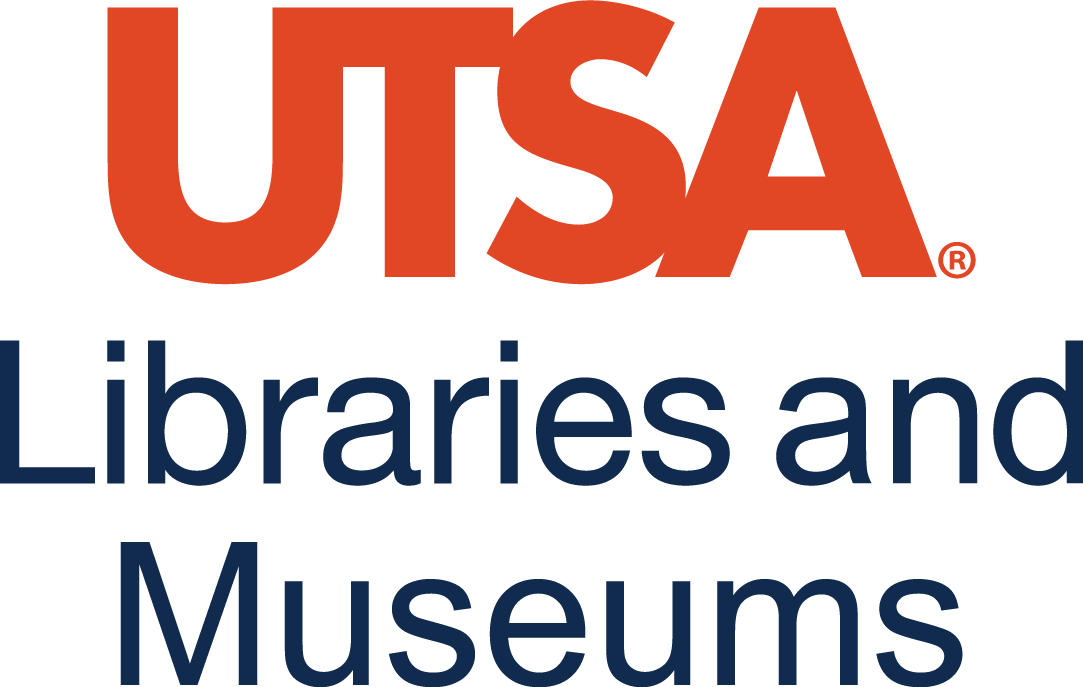2 Numbers:
Topics Covered[1]
In case you missed something in class, or just want to review a specific topic covered in this Module, here is a list of topics covered:
Identify Counting Numbers and Whole Numbers[2]
Learning algebra is similar to learning a language. You start with a basic vocabulary and then add to it as you go along. You need to practice often until the vocabulary becomes easy to you. The more you use the vocabulary, the more familiar it becomes.
Algebra uses numbers and symbols to represent words and ideas. Let’s look at the numbers first. The most basic numbers used in algebra are those we use to count objects: 1,2,3,4,5,… and so on. These are called the counting numbers. The notation “…” is called an ellipsis, which is another way to show “and so on”, or that the pattern continues endlessly. Counting numbers are also called natural numbers.
Counting Numbers
The counting numbers start with 1 and continue.
Counting numbers and whole numbers can be visualized on a number line as shown in the picture below.
 The point labeled 0 is called the origin. The points are equally spaced to the right of 0 and labeled with the counting numbers. When a number is paired with a point, it is called the coordinate of the point.
The point labeled 0 is called the origin. The points are equally spaced to the right of 0 and labeled with the counting numbers. When a number is paired with a point, it is called the coordinate of the point.
The discovery of the number zero was a big step in the history of mathematics. Including zero with the counting numbers gives a new set of numbers called the whole numbers.
Whole Numbers
The whole numbers are the counting numbers and zero.
We stopped at 5 when listing the first few counting numbers and whole numbers. We could have written more numbers if they were needed to make the patterns clear.
Try it! – Identifying Counting and Whole Numbers
Which of the following are a. counting numbers? b. whole numbers?
0, ![]() , 3, 5.2, 15, 105
, 3, 5.2, 15, 105
| Problem Number | Algebraic |
| a. | The counting numbers start at 1, so 0 is not a counting number. The numbers 3, 15, and 105 are all counting numbers. |
| b. | Whole numbers are counting numbers and 0. The numbers 0, 3, 15, and 105 are whole numbers. |
| The numbers |
|
Identify the Place Value of a Digit [3]
By looking at money and base-10 blocks, we can see that each place in a number has a different value. A place value chart is a useful way to summarize this information. The place values are separated into groups of three, called periods. The periods are ones, thousands, millions, billions, trillions, and so on. In a written number, commas separate the periods.
Just as with the base-10 blocks, where the value of the tens rod is ten times the value of the ones block and the value of the hundreds square is ten times the tens rod, the value of each place in the place-value chart is ten times the value of the place to the right of it.
The table shows how the number 5,278,194 is written in a place value chart.
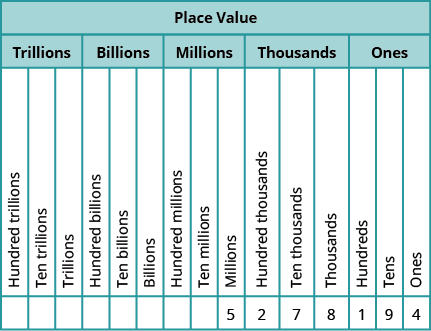
- The digit 5 is in the millions place. Its value is 5,000,000.
- The digit 2 is in the hundred thousands place. Its value is 200,000.
- The digit 7 is in the ten thousands place. Its value is 70,000.
- The digit 8 is in the thousands place. Its value is 8,000.
- The digit 1 is in the hundreds place. Its value is 100.
- The digit 9 is in the tens place. Its value is 90.
- The digit 4 is in the ones place. Its value is 4.
Try it! – Identifying Place Value
In the number 63,407,218; find the place value of each of the following digits:
- 7
- 0
- 1
- 6
- 3
Solution (click to reveal)
Write the number in a place value chart, starting at the right.
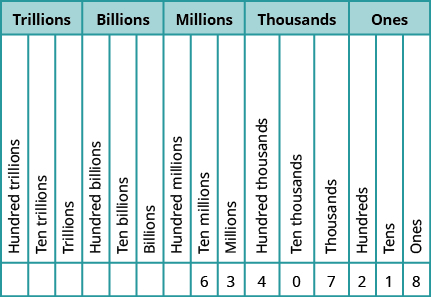
| Problem Number | Algebraic |
| a | The 7 is in the thousands place. |
| b | The 0 is in the ten thousands place. |
| c | The 1 is in the tens place. |
| d | The 6 is in the ten millions place. |
| e | The 3 is in the millions place. |
Use Place Value to Name Whole Numbers [4]
When you write a check, you write out the number in words as well as in digits. To write a number in words, write the number in each period followed by the name of the period without the ‘s’ at the end. Start with the digit at the left, which has the largest place value. The commas separate the periods, so wherever there is a comma in the number, write a comma between the words. The ones period, which has the smallest place value, is not named.

So the number 37,519,248 is written thirty-seven million, five hundred nineteen thousand, two hundred forty-eight.
Notice that the word and is not used when naming a whole number.
How To:
- Starting at the digit on the left, name the number in each period, followed by the period name. Do not include the period name for the ones.
- Use commas in the number to separate the periods.
Try it! – Naming a Number
Name the number 8,165,432,098,710 in words.
Solution (click to reveal)
| Steps | Algebraic |
| Begin with the leftmost digit, which is 8. It is in the trillions place. | eight trillion |
| The next period to the right is billions. | one hundred sixty-five billion |
| The next period to the right is millions. | four hundred thirty-two million |
| The next period to the right is thousands. | ninety-eight thousand |
| The rightmost period shows the ones. | seven hundred ten |

Putting all of the words together, we write 8,165,432,098,710 as eight trillion, one hundred sixty-five billion, four hundred thirty-two million, ninety-eight thousand, seven hundred ten. |
|
Try it! – Name a Number
Solution
Identify the periods associated with the number.
 Name the number in each period, followed by the period name. Put the commas in to separate the periods.
Name the number in each period, followed by the period name. Put the commas in to separate the periods.
| Period | Name |
| Millions period | three hundred twenty-seven million |
| Thousands period | five hundred seventy-seven thousand |
| Ones period | five hundred twenty-nine |
| So the number of mobile phone users in the Unites States during the month of April was three hundred twenty-seven million, five hundred seventy-seven thousand, five hundred twenty-nine. | |
Use Place Value to Write Whole Numbers [5]
We will now reverse the process and write a number given in words as digits.
How To:
- Identify the words that indicate periods. (Remember the ones period is never named.)
- Draw three blanks to indicate the number of places needed in each period. Separate the periods by commas.
- Name the number in each period and place the digits in the correct place value position.
Try it! – Writing Numbers
Write the following numbers using digits.
a. fifty-three million, four hundred one thousand, seven hundred forty-two
b. nine billion, two hundred forty-six million, seventy-three thousand, one hundred eighty-nine
Solution
| Problem Number | Explanation |
| a. |
Except for the first period, all other periods must have three places. Draw three blanks to indicate the number of places needed in each period. Separate the periods by commas. Then write the digits in each period.
Put the numbers together, including the commas. The number is 53,401,742. |
| b. |
Except for the first period, all other periods must have three places. Draw three blanks to indicate the number of places needed in each period. Separate the periods by commas. Then write the digits in each period.
The number is 9,246,073,189. Notice that in part b., a zero was needed as a placeholder in the hundred thousands place. Be sure to write zeros as needed to make sure that each period, except possibly the first, has three places. |
Try it! – Writing Numbers
A state budget was about $77 billion. Write the budget in standard form.
Solution
Identify the periods. In this case, only two digits are given, and they are in the billions period. To write the entire number, write zeros for all of the other periods.

So, the budget was about $77,000,000,000.
Round Whole Numbers [6]
In 2013, the U.S. Census Bureau reported the population of the state of New York as 19,651,127 people. It might be enough to say that the population is approximately 20 million. The word approximately means that 20 million is not the exact population but is close to the exact value.
The process of approximating a number is called rounding. Numbers are rounded to a specific place value depending on how much accuracy is needed. 20 million was achieved by rounding to the millions place. Had we rounded to the one hundred thousands place, we would have 19,700,000 as a result. Had we rounded to the ten thousands place, we would have 19,650,000 as a result, and so on. The place value to which we round to depends on how we need to use the number.
Using the number line can help you visualize and understand the rounding process. Look at the number line below. Suppose we want to round the number 76 to the nearest ten. Is 76 closer to 70 or 80 on the number line?

Now consider the number 72. Find 72 in the number line below.

How do we round 75 to the nearest ten. Find 75 in the number line below.

So that everyone rounds the same way in cases like this, mathematicians have agreed to round to the higher number, 80. So, 75 rounded to the nearest ten is 80.
Now that we have looked at this process on the number line, we can introduce a more general procedure. To round a number to a specific place, look at the number to the right of that place. If the number is less than 5, round down. If it is greater than or equal to 5, round up.
So, for example, to round 76 to the nearest ten, we look at the digit in the ones place.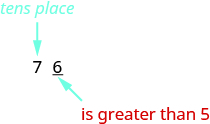 The digit in the ones place is a 6. Because 6 is greater than or equal to 5, we increase the digit in the tens place by one. So, the 7 in the tens place becomes an 8. Now, replace any digits to the right of the 8 with zeros. So, 76 rounds to 80.
The digit in the ones place is a 6. Because 6 is greater than or equal to 5, we increase the digit in the tens place by one. So, the 7 in the tens place becomes an 8. Now, replace any digits to the right of the 8 with zeros. So, 76 rounds to 80.
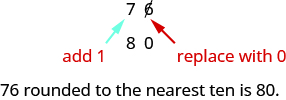 Let’s look again at rounding 72 to the nearest 10. Again, we look to the ones place.
Let’s look again at rounding 72 to the nearest 10. Again, we look to the ones place.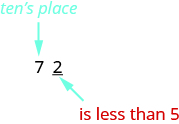 The digit in the ones place is 2. Because 2 is less than 5, we keep the digit in the tens place the same and replace the digits to the right of it with zero. So 72 rounded to the nearest ten is 70.
The digit in the ones place is 2. Because 2 is less than 5, we keep the digit in the tens place the same and replace the digits to the right of it with zero. So 72 rounded to the nearest ten is 70.
How To:
- Locate the given place value. All digits to the left of that place value do not change.
- Underline the digit to the right of the given place value.
- Determine if this digit is greater than or equal to 5.
- Yes—add 1 to the digit in the given place value.
- No—do not change the digit in the given place value.
- Replace all digits to the right of the given place value with zeros.
Try it! – Rounding Numbers
Round 843 to the nearest ten.
Solution
| Steps | Algebraic |
| Locate the tens place. |  |
| Underline the digit to the right of the tens place. |  |
| Since 3 is less than 5, do not change the digit in the tens place. |  |
| Replace all digits to the right of the tens place with zeros. |  |
| Rounding 843 to the nearest ten gives 840. |
#2 Round each number to the nearest hundred:
a. 23,658
b. 3,978
Solution
a.
| Steps |
Algebraic |
| Locate the hundreds place. |  |
| The digit of the right of the hundreds place is 5. Underline the digit to the right of the hundreds place. |  |
| Since 5 is greater than or equal to 5, round up by adding 1 to the digit in the hundreds place. Then replace all digits to the right of the hundreds place with zeros. | 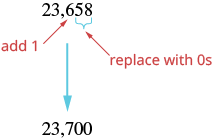 So, 23,658 rounded to the nearest hundred is 23,700. |
b.
| Steps |
Algebraic |
| Locate the hundreds place. |  |
| Underline the digit to the right of the hundreds place. |  |
| The digit to the right of the hundreds place is 7. Since 7 is greater than or equal to 5, round up by added 1 to the 9. Then place all digits to the right of the hundreds place with zeros. | 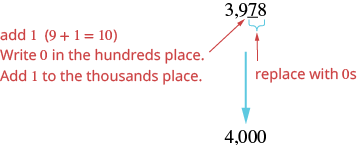 So, 3,978 rounded to the nearest hundred is 4,000. |
#3 Round each number to the nearest thousand:
a. 147,032
b. 29,504
Solution
a.
| Steps |
Algebraic |
| Locate the thousands place. Underline the digit to the right of the thousands place. |  |
| The digit to the right of the thousands place is 0. Since 0 is less than 5, we do not change the digit in the thousands place. |  |
| We then replace all digits to the right of the thousands pace with zeros. |  So, 147,032 rounded to the nearest thousand is 147,000. |
b.
| Steps | Algebraic |
| Locate the thousands place. |  |
| Underline the digit to the right of the thousands place. |  |
| The digit to the right of the thousands place is 5. Since 5 is greater than or equal to 5, round up by adding 1 to the 9. Then replace all digits to the right of the thousands place with zeros. | 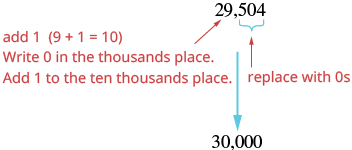 So, 29,504 rounded to the nearest thousand is 30,000. |
Notice that in part b., when we add 1 thousand to the 9 thousands, the total is 10 thousands. We regroup this as 1 ten thousand and 0 thousands. We add the 1 ten thousand to the 3 ten thousands and put a 0 in the thousands place.
Access Additional Online Resources
Key Concepts
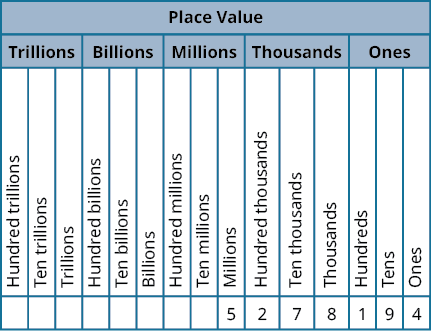
- Name a whole number in words.
- Starting at the digit on the left, name the number in each period, followed by the period name. Do not include the period name for the ones.
- Use commas in the number to separate the periods.
- Use place value to write a whole number.
- Identify the words that indicate periods. (Remember the ones period is never named.)
- Draw three blanks to indicate the number of places needed in each period.
- Name the number in each period and place the digits in the correct place value position.
- Round a whole number to a specific place value.
- Locate the given place value. All digits to the left of that place value do not change.
- Underline the digit to the right of the given place value.
- Determine if this digit is greater than or equal to 5. If yes—add 1 to the digit in the given place value. If no—do not change the digit in the given place value.
- Replace all digits to the right of the given place value with zeros.
- Access for free at https://openstax.org/books/prealgebra-2e/pages/1-introduction ↵
- Section material derived from Openstax Prealgebra: Introduction-Introduction to Whole Numbers ↵
- Section material derived from Openstax Prealgebra: Introduction-Introduction to Whole Numbers ↵
- Section material derived from Openstax Prealgebra: Introduction-Introduction to Whole Numbers ↵
- Section material derived from Openstax Prealgebra: Introduction-Introduction to Whole Numbers ↵
- Section material derived from Openstax Prealgebra: Introduction-Introduction to Whole Numbers ↵
The counting numbers are the numbers 1, 2, 3, ….
The whole numbers are the numbers 0, 1, 2, 3, ….
